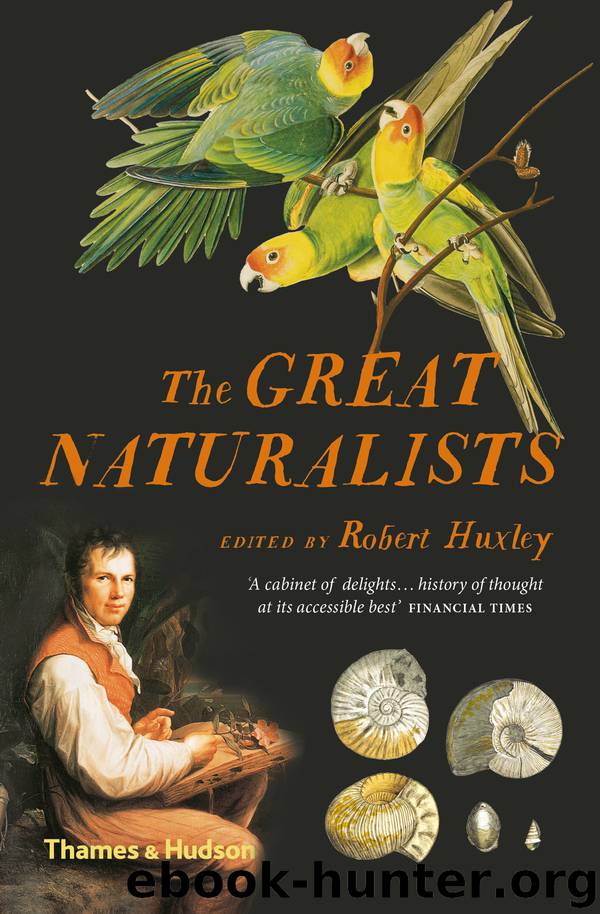The Great Naturalists by Robert Huxley

Author:Robert Huxley
Language: eng
Format: epub
Publisher: Thames & Hudson
Published: 2019-02-27T16:00:00+00:00
AMERICAN INDEPENDENCE
William Bartram was also an important scientific figure in the development of the new American Republic. He was well aware of the need for an independent scientific community that would no longer be reliant on Europe for either materials or the intellectual interpretation of American natural products. He recognized that in order to take control of their own science, Americans had to start naming, describing and classifying indigenous flora and fauna themselves, and by so doing would make a contribution to the building of an independent nation. Bartram was familiar with the views of the French naturalist Buffon (p. 121) and his followers, who claimed that American natural products, both vegetable and animal, had degenerated over time. Buffon explained that European species had in the past made their way to the American continent, where, due to the poor environmental conditions such as climate and diet, they had degenerated to become smaller, weaker and inferior to their European counterparts. Buffon applied this theory also to the indigenous people of the Americas. Bartram did not argue against the idea of environmental conditions influencing species in different regions, a theory that Humboldt was to develop in the 19th century. But that American species had degenerated was something he refuted, and did so by describing the grandeur, enormity and splendour of the flora and fauna of the continent, and its people. The Cherokee were, according to Bartram, ‘the largest race of men’ and one Seminole Prince was ‘the most perfect human figure’ he had ever seen.
Bartram dedicated a large proportion of Travels to discussing Native Americans, describing their appearance, lifestyle and culture, comparing them to Europeans and finding them equal. He provided detailed descriptions of their religious beliefs and practices, their mode of agriculture, their language and music. He even offered an explanation on the origins of the large mounds that were found in the region, identifying them as ‘Indian’. He compared the artifacts found in them with those of living Native Americans and concluded that the resemblance was enough to suggest that early Native Americans originally inhabited the sites. His theory was dismissed at the time, but is now known to be correct. Bartram developed a great admiration for the Creek and Cherokee lifestyle and culture, particularly their relationship with nature, which confirmed many of his own views. Pantheist ideas that were in embryonic form before his travels were given substance after his encounters with Native Americans.
In his writings and his drawings Bartram strove to achieve a balance between the narrow categorizing and labelling of nature that dominated much of science at the time and a comprehension of the world as an integrated whole. To him the study of nature meant understanding how species related to and were dependent on their surroundings, and what influence they in turn brought to bear on the local flora and fauna. Bartram introduced an aesthetic appreciation of nature that complemented the reasoned and rational study of the universe. He was left in no doubt that there
Download
This site does not store any files on its server. We only index and link to content provided by other sites. Please contact the content providers to delete copyright contents if any and email us, we'll remove relevant links or contents immediately.
Hit Refresh by Satya Nadella(8338)
When Breath Becomes Air by Paul Kalanithi(7264)
The Girl Without a Voice by Casey Watson(7263)
Do No Harm Stories of Life, Death and Brain Surgery by Henry Marsh(6337)
A Court of Wings and Ruin by Sarah J. Maas(6080)
Hunger by Roxane Gay(4219)
Shoe Dog by Phil Knight(4169)
Everything Happens for a Reason by Kate Bowler(4067)
A Higher Loyalty: Truth, Lies, and Leadership by James Comey(4033)
The Rules Do Not Apply by Ariel Levy(3906)
Tuesdays with Morrie by Mitch Albom(3833)
The Immortal Life of Henrietta Lacks by Rebecca Skloot(3826)
How to Change Your Mind by Michael Pollan(3679)
Millionaire: The Philanderer, Gambler, and Duelist Who Invented Modern Finance by Janet Gleeson(3569)
All Creatures Great and Small by James Herriot(3517)
Elon Musk by Ashlee Vance(3455)
Tokyo Vice: An American Reporter on the Police Beat in Japan by Jake Adelstein(3440)
Man and His Symbols by Carl Gustav Jung(3315)
The Money Culture by Michael Lewis(3284)
